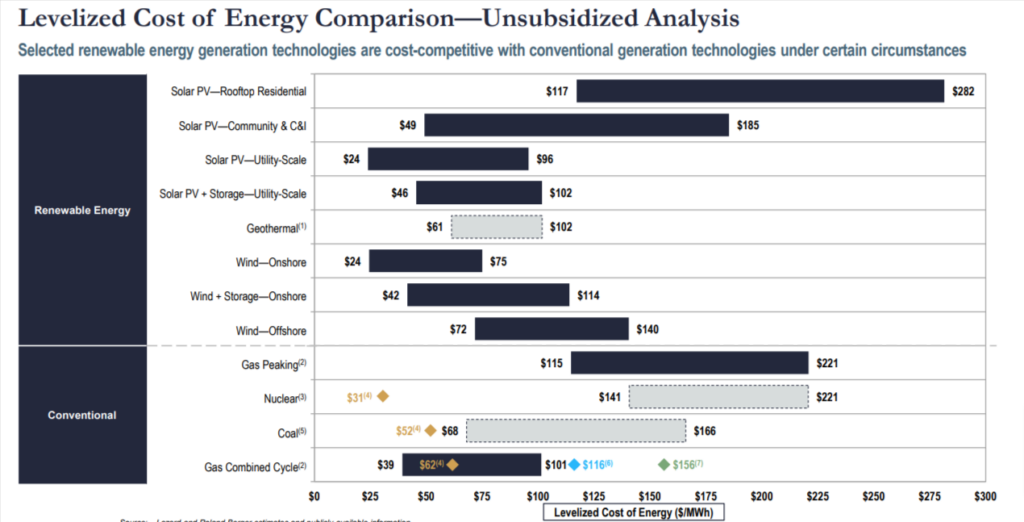
The past few years have seen energy bills skyrocket. Just as we get used to one price hike, the utility providers announce another one (Xcel – we’re looking at you!).
We’re sure you’re as fed up with it as we are, and that you are keen to understand how 2024 will pan out in terms of electricity costs.
Some big changes are going on in the energy industry and solar is seriously disrupting things in a good way. But does the increase in utility-scale solar mean you’ll actually pay less for your energy?
Let’s see what the outlook is for 2024.
In a Nutshell
- The EIA expects average electricity prices to remain the same or reduce slightly in 2024
- Stabilizing wholesale gas prices is considered to be the main reason for 2024’s electricity rates
- The cost of wholesale cast is predicted to be under $3.00/MMBtu in 2024 and 2025
- Colorado residents will, overall, see a slight decrease of 3.7% in their electricity bills
- Major Colorado utility providers are increasing their rates slightly, with Xcel requesting the largest price hikes
- Going solar will offset much of your electricity bill and give you resilience against future increased electricity costs
What Do Electricity Prices Look Like for 2024?

The outlook for wholesale energy is neither bad nor good.
According to the US Energy Information Administration (EIA), wholesale electricity prices, on average, will remain the same or slightly lower than what they were in 2023. The reason given for this is relatively stable generation fuel costs.
This could change throughout the year, however, if supply constraints or high demand cause temporary spikes.
The key component in all of this is the price of natural gas. It’s the highest-cost method of power generation (and the largest source of electricity within the USA) and those who have been keeping their eyes on the market (or regularly receiving a gas bill) will already know how much the price of this fuel has skyrocketed in recent times.
Unfortunately, many wholesale energy markets set their prices on what’s known as the “marginal cost” which is based on the highest cost for power generation (gas) and this is what has led to larger than usual energy bills.

It is expected that the U.S. benchmark natural gas spot price to average under $3.00 per million British thermal units (MMBtu) in 2024 and 2025.
This is a slight increase since 2023 as demand continues to be higher than the supply growth. However, it is also a significant decrease from 2022 when the price reached $6.50/MMBtu.
The EIA has concluded that US natural gas production growth will remain relatively flat (although growing slightly) and continue to be a driver of the lower prices.
What does this mean for your electricity bills?
Well, they’re not likely to rise by much overall but don’t expect them to decrease, either.
According to the EIA’s short-term energy outlook, this is what the average residential electricity rates are expected to be (we don’t have data for commercial rates):
| 2022 | 2023 | 2024 | 2025 | |
| Price (cents per kWh) | 15.04 | 15.93 | 15.81 | 16.19 |
The Growth of Solar vs Electricity Costs
The EIA’s short-term energy outlook also talked a lot about the growth of solar, which is really encouraging.
It is predicted that solar-generated energy will be responsible for the most growth in electricity generation in 2024 and will be responsible for a 36 GW increase in solar capacity.
In total, power plants will generate 43% more electricity from solar in 2024 than in 2023, resulting in an increase of 70 billion kilowatt-hours (BkWh). That’s a pretty awesome statistic and shows how pro-solar the USA has become in recent times.
In contrast, natural gas generation will only grow by 2% in 2024 compared with a growth of 7% in 2023. Coal-fired plants are set to decline by 8%.
This massive uptick in renewable energy will undoubtedly have a positive effect on energy bills. Unlike natural gas, solar is low-cost to produce and maintain, therefore, the wholesale cost of solar-generated electricity will be lower than that of natural gas.

According to the Lazard Levelized Cost of Energy 2023, utility-scale solar PV costs less than natural gas, and that’s before any government subsidies or incentives (like the Inflation Reduction Act) have been taken into account.
So yes, the wholesale cost of solar is expected to be lower than the cost of natural gas which may eventually reflect in our energy bills but it is not a given.
Ultimately, it will be a while before the use of solar energy surpasses our use of gas, so expect this to be a gradual thing. Additionally, you never know what other reasons utility providers will come up with to charge you more!
How About Colorado’s Electricity Rates?
How will Colorado be impacted by changes to 2024 electricity rates?
According to Electric Choice, compared with other states, Coloradans have got it good so far this year. On average, a kWh of electricity will cost 12.28¢ in January 2024, which is roughly a 3.7% reduction from the price of 12.75¢/ kWh in December 2023.
But that doesn’t mean that utilities will be raising their prices. On the contrary, most Coloradans will see some kind of increase.
Let’s take a look at what some major Colorado utility providers will be charging in 2024:
Xcel
Xcel has been the worst culprit in Colorado for energy price hikes. The utility giant consistently piled misery on its customers by introducing what seemed like a relentless stream of cost increases.
Xcel seemingly wants to continue with this trend into 2024 and has proposed the following changes to its rates:

If approved, residential customers will see a whopping 9.6% increase on their monthly bill, while small commercial can expect a modest yet unwelcome 3.3% increase.
The rates are currently under review with the Public Utilities Commission with a final decision decided in January 2024. Therefore, we should expect the results imminently.
Tri-State
Back in June 2023, the board of directors of Tri-State the cooperative’s 2024 operating budget was approved and this included a 6.36% increase in the average Class A wholesale rate.
Scheduled to go into effect in January 2024, those who use Tri-State cooperative utility providers may already be feeling the effects of this price hike.
In Tri-State’s defense, it claims it has not increased its wholesale rate for its members in seven years, and that the rate increase is significantly lower than the rate of inflation experienced in the past seven years. But still, it’s not something to look forward to.

For example, Poudre Valley Electric will be increasing its small commercial rates by 2.44% in 2024, with 2+% increases also projected for 2025 and 2026.
San Luis Valley Rural Electric (SLVREC)

SLVREC will see some very modest changes. On some tariffs, the rate of electricity has been reduced slightly and on others there is a slight increase. All in all, it’s not going to have much of an effect.
What should be noted, however, is the increase in customer and demand charges. For example, those on schedules 41, 45, and 47 will see their demand charge increase from $2.50 in 2023 to $3.35 in 2024. This is likely to make a difference to your energy bills for sure.
Offset Your Electricity Bills With Solar Energy

Rather than rely on utility-scale solar energy, why not invest in your own solar PV system?
Doing so can reduce your energy bills by up to 96% which gives you a far greater resilience against the inevitable future electricity cost increases. Sure, there’s a pretty sizeable upfront cost of getting a solar PV system installed, but with the numerous government incentives and tax credits, your costs can quickly be recouped.
And since the average solar system will last well beyond 25 years, you can continue enjoying the steady stream of low-cost energy for a very long time.
There’s another problem that solar energy addresses too.
The grid’s infrastructure is aging and crumbling and this is going to start increasing the likelihood of rolling blackouts. This is going to be further exacerbated by the explosion in the use of electric vehicles.
Additionally, utility providers aren’t going to foot the bill of updating their infrastructure – most likely, these costs will be passed on to you through increased electricity rates and charges.
Solar-generated energy – particularly if used in conjunction with solar storage (batteries) – is much more reliable and will protect you against grid-based power outages.
Moreover, if you’re generating your own power, you rely on the grid far less frequently and won’t have to suffer too much from the inflated costs related to updating grid infrastructure.
Talk to 8760 Solar
There has never been a better time to go solar. The equipment is cheaper than ever and the government incentives are huge. In fact, a Colorado farm or agricultural business can get a full return on investment in as little as one year.
The solar energy revolution is here and 8760 Solar is here to help you jump aboard!
Get in touch with a member of our friendly team to get the ball rolling. We’ll be more than happy to answer any of your queries and questions and provide you with a no-obligation quote.
Text “READY” to 719 470-0254 or email us at sales@8760solar.com and we’ll get back to you right away.
Frequently Asked Questions
What Is the Electricity Cost Outlook for 2024?
Thanks to stable fuel generation costs, the US Energy Information Administration predicts that wholesale electricity prices will remain the same or slightly lower than what they were in 2023.
What Will Natural Gas Prices Be in 2024?
The US Energy Information Administration expects the US benchmark natural gas spot price at the Henry Hub to average under $3.00 MMBtu in 2024 and 2025. This has decreased significantly from the high of $6.50/MMBtu experienced in 2022.
Will Electricity Prices Rise in the Future?
Yes, electricity prices will continue to rise in the future. The cost of electricity has been on a steady upward trajectory since records began and it is unlikely that this trend will stop anytime soon.
